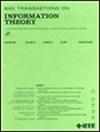Quickest Change Detection for Multiple Data Streams Using the James–Stein Estimator
IF 2.9
3区 计算机科学
Q3 COMPUTER SCIENCE, INFORMATION SYSTEMS
引用次数: 0
Abstract
The problem of quickest change detection is studied in the context of detecting an arbitrary unknown mean-shift in multiple independent Gaussian data streams. The James-Stein estimator is used in constructing detection schemes that exhibit strong detection performance both asymptotically and non-asymptotically. Our results indicate that utilizing the James-Stein estimator in the recently developed window-limited CuSum test constitutes a uniform improvement over its typical maximum likelihood variant. That is, the proposed James-Stein version achieves a smaller detection delay simultaneously for all possible post-change parameter values and every false alarm rate constraint, as long as the number of parallel data streams is greater than three. Additionally, an alternative detection procedure that utilizes the James-Stein estimator is shown to have asymptotic detection delay properties that compare favorably to existing tests. The second-order asymptotic detection delay term is reduced in a predefined low-dimensional subspace of the parameter space, while second-order asymptotic minimaxity is preserved. The results are verified in simulations, where the proposed schemes are shown to achieve smaller detection delays compared to existing alternatives, especially when the number of data streams is large.使用James-Stein估计器对多个数据流进行最快的变化检测
针对多个独立高斯数据流中任意未知均值漂移的检测问题,研究了最快变化检测问题。利用James-Stein估计量构造了具有较强渐近和非渐近检测性能的检测方案。我们的结果表明,在最近开发的窗限CuSum测试中使用James-Stein估计量构成了对其典型的最大似然变量的统一改进。即只要并行数据流的数量大于3个,所提出的James-Stein版本对所有可能的变化后参数值和每个虚警率约束同时实现较小的检测延迟。此外,利用James-Stein估计器的另一种检测过程被证明具有与现有测试相比有利的渐近检测延迟特性。将二阶渐近检测延迟项约简到参数空间的低维子空间中,同时保持了二阶渐近极小值。结果在模拟中得到验证,与现有的替代方案相比,所提出的方案显示出更小的检测延迟,特别是当数据流数量很大时。
本文章由计算机程序翻译,如有差异,请以英文原文为准。
求助全文
约1分钟内获得全文
求助全文
来源期刊

IEEE Transactions on Information Theory
工程技术-工程:电子与电气
CiteScore
5.70
自引率
20.00%
发文量
514
审稿时长
12 months
期刊介绍:
The IEEE Transactions on Information Theory is a journal that publishes theoretical and experimental papers concerned with the transmission, processing, and utilization of information. The boundaries of acceptable subject matter are intentionally not sharply delimited. Rather, it is hoped that as the focus of research activity changes, a flexible policy will permit this Transactions to follow suit. Current appropriate topics are best reflected by recent Tables of Contents; they are summarized in the titles of editorial areas that appear on the inside front cover.
 求助内容:
求助内容: 应助结果提醒方式:
应助结果提醒方式:


